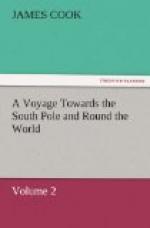We stood off till noon, and then tacked for the land again, in order to see whether it was an island or no. The weather was now become very hazy, which soon turning to a thick fog, put a stop to discovery, and made it unsafe to stand for the shore; so that after having run the same distance in, as we had run off, we tacked and stood to N.W., for the land we had seen in the morning, which was yet at a considerable distance. Thus we were obliged to leave the other, under the supposition of its being an island, which I named Saunders, after my honourable friend Sir Charles. It is situated in the latitude of 57 deg. 49’ south longitude, 26 deg. 44’ west; and north, distant thirteen leagues, from Cape Montagu.
At six o’clock in the evening, the wind shifting to the west, we tacked, and stood to the north; and at eight the fog clearing away, gave us a sight of Saunders’s Isle, extending from S.E. by S. to E.S.E. We were still in doubt if it was an island; for, at this time, land was seen bearing E. by S., which might or might not be connected with it; it might also be the same that we had seen the preceding evening. But, be this as it may, it was now necessary to take a view of the land to the north, before we proceeded any farther to the east. With this intention, we stood to the north, having a light breeze at W. by S., which at two o’clock in the morning of the 3d, was succeeded by a calm that continued till eight, when we got the wind at E. by S. attended by hazy weather. At this time we saw the land we were looking for, and which proved to be two isles. The day on which they were discovered, was the occasion of calling them Candlemas Isles; latitude 57 deg. 11’ S., longitude 27 deg. 6’ W. They were of no great extent, but of considerable height, and were covered with snow. A small rock was seen between them, and perhaps there may be more; for the weather was so hazy that we soon lost sight of the islands, and did not see them again till noon, at which time they bore west, distant three or four leagues.
As the wind kept veering to the south, we were obliged to stand to the N.E., in which route we met with several large ice islands, loose ice, and many penguins; and at midnight, came at once into water uncommonly white, which alarmed the officer of the watch so much, that he tacked the ship instantly. Some thought it was a float of ice; others that it was shallow water; but, as it proved neither, probably it was a shoal of fish.
We stood to the south till two o’clock next morning, when we resumed our course to the east with a faint breeze at S.S.E. which having ended in a calm, at six, I took the opportunity of putting a boat in the water to try if there were any current; and the trial proved there was none. Some whales were playing about us, and abundance of penguins: a few of the latter were shot, and they proved to be of the same sort that we had seen among the ice before, and different both from those on Staten Land, and




